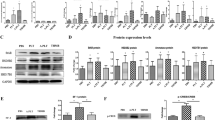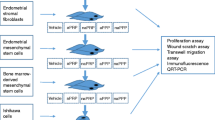Abstract
Platelets have been recently revealed to play important roles in the development of endometriosis. However, it is unclear whether endometriotic lesions can secrete any platelet inducers outside the menstruation window. Hence, this study was undertaken to see whether endometriosis-derived stromal cells secrete platelet activators and cause platelet activation. We employed in vitro experimentation using primary ectopic endometrial stromal cells (EESCs) and platelets from healthy male volunteers and evaluated the extent of platelet aggregation by aggregometer and the platelet activation rate by flow cytometry using supernatants harvested from EESCs of different cell densities. We also measured the concentration of thromboxane B2 (TXB2), a metabolite of thromboxane A2 (TXA2), and thrombin activity in supernatants harvested from EESCs of different densities and evaluated the extent of platelet aggregation after treatment of EESCs with hirudin, Ozagrel, and apyrase. Finally, the concentration of TXB2, thrombin, and transforming growth factor β1 (TGF-β1) in platelets cocultured with different densities of EESCs is measured by enzyme-linked immunosorbent assay. We found that EESCs secrete thrombin and TXA2 and induce platelet activation and aggregation in a density-dependent fashion. Treatment of platelets with EESCs resulted in increased concentration of TXB2, thrombin, and TGF-β1 in a density-dependent manner. Treatment of EESCs with hirudin and Ozagrel, but not apyrase, resulted in significant suppression of platelet aggregation. Thus, given recently reported effects of activated platelets on the cell behaviors of EESCs and endometriotic lesions in general, our findings establish that endometriotic lesions and platelets engage active cross-talks in the development of endometriosis, highlighting the importance of lesion microenvironment in endometriosis.
Similar content being viewed by others
References
Giudice LC, Kao LC. Endometriosis. Lancet. 2004;364(9447):1789–1799.
Guo SW. An overview of the current status of clinical trials on endometriosis: issues and concerns. Fertil Steril. 2014;101(1):183–190. e4.
Bulun SE, Lin Z, Imir G, et al. Regulation of aromatase expression in estrogen-responsive breast and uterine disease: from bench to treatment. Pharmacol Rev. 2005;57(3):359–383.
Burney RO, Giudice LC. Pathogenesis and pathophysiology of endometriosis. Fertil Steril. 2012;98(3):511–519.
Akoum A, Lemay A, Paradis I, Rheault N, Maheux R. Secretion of interleukin-6 by human endometriotic cells and regulation by proinflammatory cytokines and sex steroids. Hum Reprod. 1996;11(10):2269–2275.
Wu MY, Ho HN. The role of cytokines in endometriosis. Am J Reprod Immunol. 2003;49(5):285–296.
Guo SW. Nuclear factor-kappab (NF-kappaB): an unsuspected major culprit in the pathogenesis of endometriosis that is still at large?. Gynecol Obstet Invest. 2007;63(2):71–97.
Gonzalez-Ramos R, Donnez J, Defrere S, et al. Nuclear factor-kappa B is constitutively activated in peritoneal endometriosis. Mol Hum Reprod. 2007;13(7):503–509.
Gonzalez-Ramos R, Van Langendonckt A, Defrere S, et al. Involvement of the nuclear factor-kappaB pathway in the pathogenesis of endometriosis. Fertil Steril. 2010;94(6):1985–1994.
Nomiyama M, Hachisuga T, Sou H, et al. Local immune response in infertile patients with minimal endometriosis. Gynecol Obstet Invest. 1997;44(1):32–37.
Khan KN, Masuzaki H, Fujishita A, Kitajima M, Sekine I, Ishimaru T. Differential macrophage infiltration in early and advanced endometriosis and adjacent peritoneum. Fertil Steril. 2004;81(3):652–661.
Bacci M, Capobianco A, Monno A, et al. Macrophages are alternatively activated in patients with endometriosis and required for growth and vascularization of lesions in a mouse model of disease. Am J Pathol. 2009;175(2):547–556.
Petaja J. Inflammation and coagulation. An overview. Thromb Res. 2011;127(suppl 2):s34–s37.
Lipinski S, Bremer L, Lammers T, Thieme F, Schreiber S, Rosenstiel P. Coagulation and inflammation. Molecular insights and diagnostic implications. Hamostaseologie. 2011;31(2):94–102, 104.
Semple JW, Italiano JE Jr, Freedman J. Platelets and the immune continuum. Nat Rev Immunol. 2011;11(4):264–274.
Vieira-de-Abreu A, Campbell RA, Weyrich AS, Zimmerman GA. Platelets: versatile effector cells in hemostasis, inflammation, and the immune continuum. Semin Immunopathol. 2012;34(1):5–30.
Sreeramkumar V, Adrover JM, Ballesteros I, et al. Neutrophils scan for activated platelets to initiate inflammation. Science. 2014;346(6214):1234–1238.
Ding D, Liu X, Duan J, Guo SW. Platelets are an unindicted culprit in the development of endometriosis: clinical and experimental evidence. Hum Reprod. 2015;30(4):812–832.
Zhang Q, Ding D, Liu X, Guo SW. Activated Platelets Induce Estrogen Receptor beta Expression in Endometriotic Stromal Cells. Gynecol Obstet Invest. 2015;80(3):187–192.
Guo SW, Ding D, Geng JG, Wang L, Liu X. P-selectin as a potential therapeutic target for endometriosis. Fertil Steril. 2015;103(4):990–1000. e8.
Brosens IA. Endometriosis–a disease because it is characterized by bleeding. Am J Obstet Gynecol. 1997;176(2):263–267.
Ryan IP, Schriock ED, Taylor RN. Isolation, characterization, and comparison of human endometrial and endometriosis cells in vitro. J Clin Endocrinol Metab. 1994;78(3):642–649.
Rydel TJ, Tulinsky A, Bode W, Huber R. Refined structure of the hirudin-thrombin complex. J Mol Biol. 1991;221(2):583–601.
Loo MH, Egan D, Vaughan ED Jr, Marion D, Felsen D, Weisman S. The effect of the thromboxane A2 synthesis inhibitor OKY-046 on renal function in rabbits following release of unilateral ureteral obstruction. J Urol. 1987;137(3):571–576.
Enomoto Y, Adachi S, Matsushima-Nishiwaki R, et al. Thromboxane A(2) promotes soluble CD40 ligand release from human platelets. Atherosclerosis. 2010;209(2):415–421.
Heinmoller E, Weinel RJ, Heidtmann HH, et al. Studies on tumor-cell-induced platelet aggregation in human lung cancer cell lines. J Cancer Res Clin Oncol. 1996;122(12):735–744.
Merolla M, Nardi MA, Berger JS. Centrifugation speed affects light transmission aggregometry. Int J Lab Hematol. 2012;34(1):81–85.
Kim SD, Lee YJ, Baik JS, et al. Baicalein inhibits agonist- and tumor cell-induced platelet aggregation while suppressing pulmonary tumor metastasis via cAMP-mediated VASP phosphorylation along with impaired MAPKs and PI3K-Akt activation. Biochem Pharmacol. 2014;92(2):251–265.
Maloney JP, Silliman CC, Ambruso DR, Wang J, Tuder RM, Voelkel NF. In vitro release of vascular endothelial growth factor during platelet aggregation. Am J Physiol. 1998;275(3 pt 2):h1054–h1061.
Kerk N, Strozyk EA, Poppelmann B, Schneider SW. The mechanism of melanoma-associated thrombin activity and von Willebrand factor release from endothelial cells. J Invest Dermatol. 2010;130(9):2259–2268.
R Core Team: A Language and Environment for Statistical Computing. Vienna, AU: R Foundation for Statistical Computing; 2015.
Smyth SS, McEver RP, Weyrich AS, et al. Platelet functions beyond hemostasis. J Thromb Haemost. 2009;7(11):1759–1766.
Ginsberg MH, Loftus J, Plow EF. Platelets and the adhesion receptor superfamily. Prog Clin Biol Res. 1988;283:171–195.
Celi A, Lorenzet R, Furie B, Furie BC. Platelet-leukocyteendothelial cell interaction on the blood vessel wall. Semin Hematol. 1997;34(4):327–335.
Shaw TJ, Martin P. Wound repair at a glance. J Cell Sci. 2009; 122(pt 18):3209–3213.
Franco AT, Corken A, Ware J. Platelets at the interface of thrombosis, inflammation, and cancer. Blood. 2015;126(5):582–588.
Wu Q, Ding D, Liu X, Guo SW. Evidence for a Hypercoagulable State in Women With Ovarian Endometriomas. Reprod Sci. 2015;22(9):1107–1114.
Rogers PA, Plunkett D, Affandi B. Perivascular smooth muscle alpha-actin is reduced in the endometrium of women with progestin-only contraceptive breakthrough bleeding. Hum Reprod. 2000;15(suppl 3):78–84.
Gasic GJ, Gasic TB, Stewart CC. Antimetastatic effects associated with platelet reduction. Proc Natl Acad Sci U S A. 1968;61(1):46–52.
Karpatkin S, Ambrogio C, Pearlstein E. The role of tumorinduced platelet aggregation, platelet adhesion and adhesive proteins in tumor metastasis. Prog Clin Biol Res. 1988;283:585–606.
Bastida E, Ordinas A, Giardina SL, Jamieson GA. Differentiation of platelet-aggregating effects of human tumor cell lines based on inhibition studies with apyrase, hirudin, and phospholipase. Cancer Res. 1982;42(11):4348–4352.
Nieswandt B, Hafner M, Echtenacher B, Mannel DN. Lysis of tumor cells by natural killer cells in mice is impeded by platelets. Cancer Res. 1999;59(6):1295–1300.
Salgado R, Vermeulen PB, Benoy I, et al. Platelet number and interleukin-6 correlate with VEGF but not with bFGF serum levels of advanced cancer patients. Br J Cancer. 1999;80(5–6):892–897.
Pearlstein E, Ambrogio C, Gasic G, Karpatkin S. Inhibition of the platelet-aggregating activity of two human adenocarcinomas of the colon and an anaplastic murine tumor with a specific thrombin inhibitor, dansylarginine N-(3-ethyl-1,5-pentanediyl)amide. Cancer Res. 1981;41(11 pt 1):4535–4539.
Kahn ML, Nakanishi-Matsui M, Shapiro MJ, Ishihara H, Coughlin SR. Protease-activated receptors 1 and 4 mediate activation of human platelets by thrombin. J Clin Invest. 1999;103(6):879–887.
Osuga Y, Hirota Y, Yoshino O, Hirata T, Koga K, Taketani Y. Proteinase-activated receptors in the endometrium and endometriosis. Front Biosci (Schol Ed). 2012;4:1201–1212.
Lin M, Weng H, Wang X, Zhou B, Yu P, Wang Y. The role of tissue factor and protease-activated receptor 2 in endometriosis. Am J Reprod Immunol. 2012;68(3):251–257.
Krikun G, Lockwood CJ, Paidas MJ. Tissue factor and the endometrium: from physiology to pathology. Thromb Res. 2009;124(4):393–396.
Coughlin SR. Thrombin signalling and protease-activated receptors. Nature. 2000;407(6801):258–264.
Nierodzik ML, Karpatkin S. Thrombin induces tumor growth, metastasis, and angiogenesis: Evidence for a thrombin-regulated dormant tumor phenotype. Cancer Cell. 2006;10(5):355–362.
Hu L, Roth JM, Brooks P, Luty J, Karpatkin S. Thrombin upregulates cathepsin D which enhances angiogenesis, growth, and metastasis. Cancer Res. 2008;68(12):4666–4673.
Shen RF, Tai HH. Thromboxanes: synthase and receptors. J Biomed Sci. 1998;5(3):153–172.
Needleman P, Moncada S, Bunting S, Vane JR, Hamberg M, Samuelsson B. Identification of an enzyme in platelet microsomes which generates thromboxane A2 from prostaglandin endoperoxides. Nature. 1976;261(5561):558–560.
Pradono P, Tazawa R, Maemondo M, et al. Gene transfer of thromboxane A(2) synthase and prostaglandin I(2) synthase antithetically altered tumor angiogenesis and tumor growth. Cancer Res. 2002;62(1):63–66.
Moussa O, Yordy JS, Abol-Enein H, et al. Prognostic and functional significance of thromboxane synthase gene overexpression in invasive bladder cancer. Cancer Res. 2005;65(24):11581–11587.
Huang RY, Li SS, Guo HZ, et al. Thromboxane A2 exerts promoting effects on cell proliferation through mediating cyclooxygenase-2 signal in lung adenocarcinoma cells. J Cancer Res Clin Oncol. 2014;140(3):375–386.
Lin H, Li HF, Lian WS, et al. Thromboxane A2 mediates ironoverload cardiomyopathy in mice through calcineurin-nuclear factor of activated T cells signaling pathway. Circ J. 2013;77(10):2586–2595.
Sumimoto S, Muramatsu R, Yamashita T. Thromboxane A2 stimulates neurite outgrowth in cerebral cortical neurons via mitogen activated protein kinase signaling. Brain Res. 2015;1594:46–51.
Tokushige N, Markham R, Russell P, Fraser IS. Nerve fibres in peritoneal endometriosis. Hum Reprod. 2006;21(11):3001–3007.
Koike H, Egawa H, Ohtsuka T, Yamaguchi M, Ikenoue T, Mori N. Eicosanoids production in endometriosis. Prostaglandins Leukot Essent Fatty Acids. 1992;45(4):313–317.
Koike H, Egawa H, Ohtsuka T, Yamaguchi M, Ikenoue T, Mori N. Correlation between dysmenorrheic severity and prostaglandin production in women with endometriosis. Prostaglandins Leukot Essent Fatty Acids. 1992;46(2):133–137.
Wilhelmsson L, Wikland M, Wiqvist N. PGH2, TxA2 and PGI2 have potent and differentiated actions on human uterine contractility. Prostaglandins. 1981;21(2):277–286.
Born GV. Effects of adenosine diphosphate (ADP) and related substances on the adhesiveness of platelets in vitro and in vivo. Br J Haematol. 1966;12(1):37–38.
Honn KV, Steinert BW, Moin K, Onoda JM, Taylor JD, Sloane BF. The role of platelet cyclooxygenase and lipoxygenase pathways in tumor cell induced platelet aggregation. Biochem Biophys Res Commun. 1987;145(1):384–389.
Coppinger JA, Cagney G, Toomey S, et al. Characterization of the proteins released from activated platelets leads to localization of novel platelet proteins in human atherosclerotic lesions. Blood. 2004;103(6):2096–2104.
Hull ML, Escareno CR, Godsland JM, et al. Endometrialperitoneal interactions during endometriotic lesion establishment. Am J Pathol. 2008;173(3):700–715.
Hull ML, Johan MZ, Hodge WL, Robertson SA, Ingman WV. Host-derived TGFB1 deficiency suppresses lesion development in a mouse model of endometriosis. Am J Pathol. 2012;180(3):880–887.
Yavuzcan A, Caglar M, Ustun Y, et al. Evaluation of mean platelet volume, neutrophil/lymphocyte ratio and platelet/lymphocyte ratio in advanced stage endometriosis with endometrioma. J Turk Ger Gynecol Assoc. 2013;14(4):210–215.
Evsen MS, Soydinc HE, Sak ME, et al. Increased platelet count in severe peritoneal endometriosis. Clin Exp Obstet Gynecol. 2014;41(4):423–425.
Avcioglu SN, Altinkaya SO, Kucuk M, Demircan-Sezer S, Yuksel H. Can platelet indices be new biomarkers for severe endometriosis?. ISRN Obstet Gynecol. 2014;2014:713542.
Krikun G, Hu Z, Osteen K, et al. The immunoconjugate “icon” targets aberrantly expressed endothelial tissue factor causing regression of endometriosis. Am J Pathol. 2010;176(2):1050–1056.
Author information
Authors and Affiliations
Corresponding author
Rights and permissions
About this article
Cite this article
Guo, SW., Du, Y. & Liu, X. Endometriosis-Derived Stromal Cells Secrete Thrombin and Thromboxane A2, Inducing Platelet Activation. Reprod. Sci. 23, 1044–1052 (2016). https://doi.org/10.1177/1933719116630428
Published:
Issue Date:
DOI: https://doi.org/10.1177/1933719116630428




